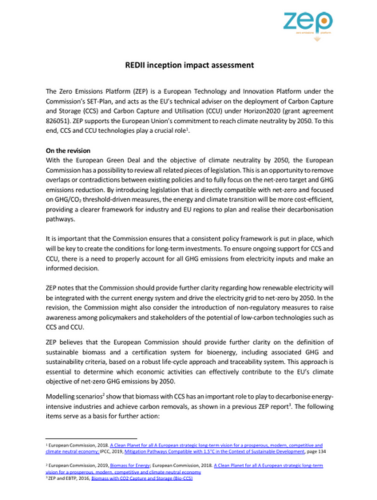REDII inception impact assessment
With the European Green Deal and the objective of climate neutrality by 2050, the European Commission has the possibility to review all related pieces of legislation. This is an opportunity to remove overlaps or contradictions between existing policies and to fully focus on the net-zero target and GHG emissions reduction. By introducing legislation that is directly compatible with net-zero and focused on GHG/CO2 threshold-driven measures, the energy and climate transition will be more cost-efficient, providing a clearer framework for industry and EU regions to plan and realise their decarbonisation pathways.
The Zero Emissions Platform (ZEP) is a European Technology and Innovation Platform under the Commission’s SET-Plan, and acts as the EU’s technical adviser on the deployment of Carbon Capture and Storage (CCS) and Carbon Capture and Utilisation (CCU) under Horizon2020 (grant agreement 826051). ZEP supports the European Union’s commitment to reach climate neutrality by 2050. To this end, CCS and CCU technologies play a crucial role.
On the revision
With the European Green Deal and the objective of climate neutrality by 2050, the European Commission has the possibility to review all related pieces of legislation. This is an opportunity to remove overlaps or contradictions between existing policies and to fully focus on the net-zero target and GHG emissions reduction. By introducing legislation that is directly compatible with net-zero and focused on GHG/CO2 threshold-driven measures, the energy and climate transition will be more cost-efficient, providing a clearer framework for industry and EU regions to plan and realise their decarbonisation pathways.
The Commission must ensure that a consistent policy framework is put in place, which will be key to creating the conditions for long-term investments. To ensure ongoing support for CCS and CCU, there is a need to properly account for all GHG emissions from electricity inputs and make an informed decision.
ZEP notes that the Commission should provide further clarity regarding how renewable electricity will
be integrated with the current energy system and drive the electricity grid to net-zero by 2050. In the
revision, the Commission might also consider the introduction of non-regulatory measures to raise
awareness among policymakers and stakeholders of the potential of low-carbon technologies such as
CCS and CCU.
ZEP believes that the European Commission should provide further clarity on the definition of sustainable biomass and a certification system for bioenergy, including associated GHG and sustainability criteria, based on a robust life-cycle approach and traceability system. This approach is essential to determine which economic activities can effectively contribute to the EU’s climate objective of net-zero GHG emissions by 2050.
Modelling scenarios show that biomass with CCS has an important role to play in decarbonising energy-intensive industries and achieving carbon removals, as shown in a previous ZEP report. The following items serve as a basis for further action:
- While awaiting the revision of the EU ETS and in the absence of a higher carbon price, economic incentives for CDR are needed.
- The development of CO2 transport and storage infrastructure is critical to deliver early, large-scale volumes of CDR.
- The Commission and Taxonomy Platform should consider including CDR and related economic activities (Bioenergy with CCS, Waste-to-Energy with CCS) in the European Taxonomy for Sustainable Finance.
- Support and continue R&D activities and invest in innovative CO2 capture technologies.
An integrated energy system will also benefit from more flexible power generation. CCS can bring flexibility, enabling decarbonised and flexible electricity production, and, when combined with bioenergy and waste incineration for power and heat, CCS can deliver mitigation and also remove CO2 from the atmosphere at a large scale.
CCS and CO2 infrastructure can also enable the production of early volumes of low-carbon hydrogen
to be dispatched to industries and homes within this decade. In a previous paper for the delegated act on climate mitigation of the European Taxonomy for Sustainable Finance, ZEP addressed the matter of hydrogen manufacturing, stressing that the electricity used in the process should be correlated both temporally and geographically with the production of hydrogen. The former criterion would be based on when the electricity is produced and when it is consumed in the manufacturing; the latter would ensure that the electricity production purchased is dispatched in the same integrated electricity grid.
